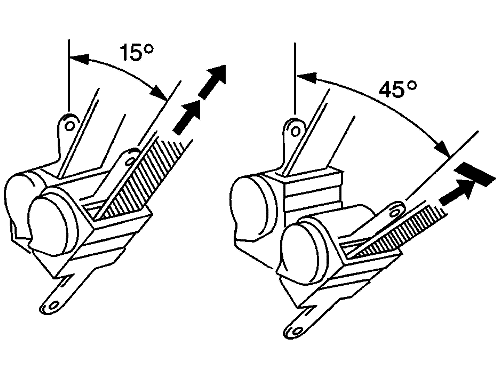Seat Belt System Operational and Functional Checks
Front and Rear Seat Belt Retractors
Front and rear seat belt retractors will lock under the following conditions:
| • | The vehicle exceeds a 15 degree angle |
| • | The vehicle exceeds 0.60 g of deceleration force |
| • | The webbing is pulled out of the retractor rapidly |
| • | During hard cornering or while descending a winding downhill grade |
| • | While braking to stop at a downhill intersection |
All retractors will unlock when 25.4 mm (1 in) of the belt is fed back into the retractor.
Static Test

- Remove the retractor assembly.
- Tilt the retractor slowly.
- Verify that the belt can be pulled out of the retractor at an inclination of 15 degrees or less, but not at an inclination of 45 degrees or more.
Static Test Seat Belts with Child Hold-Out Mechanism (CHOM) Feature
Front Passenger Seat, Rear Outboard Seats
- Pull the seat belts all the way out of the retractor.
- Feed a few inches of belt back into the retractor and listen for the audible clicking of the child hold-out mechanism (CHOM) system.
- Verify that the belt cannot be pulled out of the retractor.
- Feed the seat belt all of the way into the retractor and verify that the belt returns to normal operating conditions.
If the seat belt webbing will not retract, refer to Seat Belt Does Not Retract .
Safety Belt Operational Checks
Front and Rear Restraints
The front seats and rear seats have a three-point seat belt system with a seat belt retractor. The rear seat latch plate should move up and down easily on the belt. An audible click should be heard when the front or rear latch plate is inserted into the buckle. Inspect the attachment of the latch plate to the buckle by grasping the belt and pulling firmly. The belt should disconnect easily when the button on the buckle is pushed in.
| © Copyright Chevrolet. All rights reserved |
